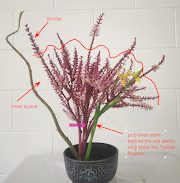Ikebana Aesthetic Program - Level 1.1 Balance (13 January 2024)

When: (Melbourne, Australia Time) Check your local time.
9:00-9:30AM 2:00 - 2:30 PM (AEDT), 13 January 2024
This is the first session (level 1.1) of our Ikebana Aesthetic Curriculum, which consists of 24 sessions (level 1: 8 sessions, level 2: 8 sessions & level 3: 8 sessions).
Our goal is to teach the essence of ikebana more efficiently and more economically so that we will have more ikebana teachers who can teach the true essence of ikebana well.
Learning ikebana is very different from learning Western flower arrangement. While many ikebana courses are taught in similar ways as Western flower arrangement, Zoom Ikebana Dojo adopts a unique approach that focuses on the creative process rather than the product.
We see the goal of ikebana as deepening your meditation on nature, not just creating a beautiful design.
You will learn the tools on how to think (or analyse) in ikebana in level 1 & 2. Our level 3 aims to go beyond learning design principles and encourages you to meditate deeply in the process of creating ikebana. Our teaching in level 3 is simple: think deeper until your thinking becomes meditation.
Zoom Ikebana Dojo is a unique ikebana course that is based on the traditional ikebana philosophy, while implementing a number of new teaching methods.
Topic: Balance 1
Video Tutorial: https://youtu.be/0qUCBeIhOFU
The first step in learning ikebana is to be familiar with asymmetrical balance. Trying to use asymmetrical triangles in your design is a great way to enhance your design. In the sample work the three points form an irregular triangle.
For more about Balance in ikebana, refer to a short essay, "Introduction to Ikebana Aesthetics" by Dr Shoso Shimbo (available shortly in English & Japanese).
What You Need
1. secateur
2. kenzan or florist form or wire packed container (see a photo below)
3. container - any include a cup
4. flower materials - long leaves (such as iris or NZ flax) and a few flowers (such as lilies, roses or any flower from your garden). Flower materials are guide only. You can choose any other materials as long as you focus on the topic .

How to Make It?
1. Measure the length of container (hight + diameter). If your container's hight is 5 cm and diameter is 10cm, the length of your container is 15cm.
2. Prepare the longest leave - 3 X Length of Container. In our example, the longest leave should be about 45cm.
3. Prepare the 2nd Longest leave - about 75% of the longest leave.
4. Prepare the main flower. Adjust its highest so that the leaves and the flower head forms a sharp triangle. See the photo above.
5. Fill unnecessary spaces using fillers, i.e. other flowers or leaves. Those fillers should be smaller or shorter so that the main flower can remain as the focal point. Don’t overuse fillers.
What's Next?
1. Book to join Zoom Ikebana Dojo by 8 January 2024. That is the first step.
2. Receive a link to join our Zoom meeting. Also you may receive a special session notes or a link to members only video.
3. Make your work and take a photo of it.
4. Send your photo to our facilitator before the Zoom meeting.
5. Join Zoom Ikebana Dojo. Enjoy friendly feedback from our facilitator and other participants.
References
Shimbo, S. (2021). Ikebana: Flower Arrangement in Search of Poetry, Garland Magazine.
Shimbo, S. (2020). 短期公開講座におけるいけ花紹介案
Shimbo, S. How to Learn Ikebana
Video Tutorial: https://youtu.be/0qUCBeIhOFU
The first step in learning ikebana is to be familiar with asymmetrical balance. Trying to use asymmetrical triangles in your design is a great way to enhance your design. In the sample work the three points form an irregular triangle.
For more about Balance in ikebana, refer to a short essay, "Introduction to Ikebana Aesthetics" by Dr Shoso Shimbo (available shortly in English & Japanese).
What You Need
1. secateur
2. kenzan or florist form or wire packed container (see a photo below)
3. container - any include a cup
4. flower materials - long leaves (such as iris or NZ flax) and a few flowers (such as lilies, roses or any flower from your garden). Flower materials are guide only. You can choose any other materials as long as you focus on the topic .

How to Make It?
1. Measure the length of container (hight + diameter). If your container's hight is 5 cm and diameter is 10cm, the length of your container is 15cm.
2. Prepare the longest leave - 3 X Length of Container. In our example, the longest leave should be about 45cm.
3. Prepare the 2nd Longest leave - about 75% of the longest leave.
4. Prepare the main flower. Adjust its highest so that the leaves and the flower head forms a sharp triangle. See the photo above.
5. Fill unnecessary spaces using fillers, i.e. other flowers or leaves. Those fillers should be smaller or shorter so that the main flower can remain as the focal point. Don’t overuse fillers.
What's Next?
1. Book to join Zoom Ikebana Dojo by 8 January 2024. That is the first step.
2. Receive a link to join our Zoom meeting. Also you may receive a special session notes or a link to members only video.
3. Make your work and take a photo of it.
4. Send your photo to our facilitator before the Zoom meeting.
5. Join Zoom Ikebana Dojo. Enjoy friendly feedback from our facilitator and other participants.
References
Shimbo, S. (2021). Ikebana: Flower Arrangement in Search of Poetry, Garland Magazine.
Shimbo, S. (2020). 短期公開講座におけるいけ花紹介案
Shimbo, S. How to Learn Ikebana






















